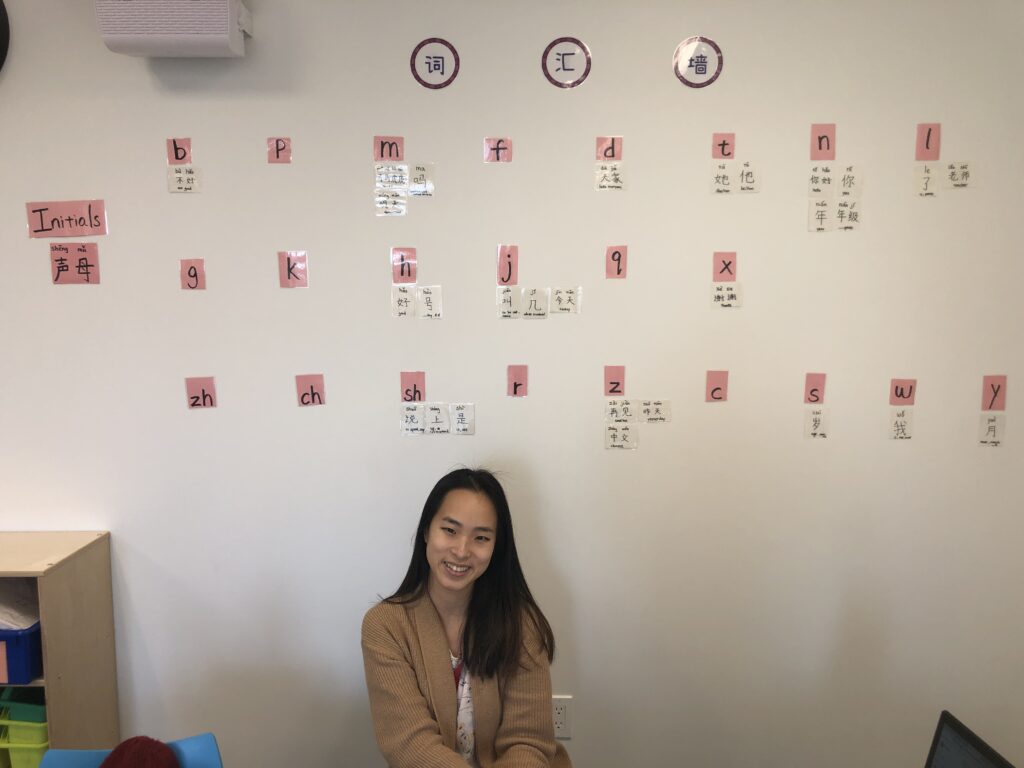Every day in Sien Li’s Grade 2 Mandarin class at TRCS2 in Elmhurst, Queens, students perform a series of steps to get them thinking in Chinese. This transition from an English-speaking to a fully immersive Mandarin environment begins even before entering the classroom, as students notice Chinese artifacts and artwork on the walls. Students efficiently gather around Ms. Sien in a circle on the bright-blue carpet and formally greet their teacher with a clipped “Ni hao!” and a slight bow. Every inch of wall space that surrounds them, from the calendar to the class rules, is displayed in Chinese. At that moment, young students fully immerse themselves in the language as they sing, sign, talk, and think in Mandarin. According to CARLA (Center for Advanced Research on Language Acquisition) the kinesthetic aspects of early immersion language learning increases cognitive skill development: “There’s a well-established, positive relationship between basic thinking skills and being a fully proficient bilingual who maintains regular use of both languages. Fully proficient bilinguals outperform monolinguals in the areas of divergent thinking, pattern recognition, and problem solving.”

Unlike many public and even some prestigious private schools, TRCS begins its Mandarin language program in Kindergarten, not middle or high school. “Spanish (a common language taken in school) is listed as a Category 1 language, whereas Mandarin is a Category 4,” Sien explains. “The number of hours needed to move to the next level in Mandarin is 400 hours, while Spanish only requires 200 hours.” Starting TRCS students learning Mandarin younger gives them more time to accrue the hours needed to become proficient. It’s no wonder that Sien’s eventual goal is for TRCS2 graduates to pass the NYSSB exam, granting them “The Seal of Biliteracy.” The NYSSB takes the form of a seal on the student’s diploma and a medallion worn at graduation.
At TRCS – Jackson Heights, in Tanya Liu’s class, the students learn how to write the strokes and are writing in Mandarin characters. Fifth-grade students are learning numbers, fruits, and animals. They’re learning how to say their age, grade level, and details about their family, but they are also practicing valuable interpersonal skills. They’re actively listening to each other while talking with their hands, bodies and through song.

Prior to teaching at TRCS, both Sien and Tanya taught students and adults in Mandarin. They both hope to bridge the gap between not only cultures but to offer students different perspectives. They believe if they expose students to another language, it’ll help them long-term. Sien is also aware of the fears that students may have when deciding on what language to take in middle and high school. The thought of taking a Mandarin class may frighten a student and they may think it is too difficult to take and pass. Spanish (a common language taken in school) is listed as a category 1 language, whereas Mandarin is a category 4. The number of hours needed to move to the next level in Mandarin is 400 hours, while Spanish only requires 200 hours. This way, starting students in Kindergarten sets them up for success as early as possible, empowering them to embark upon further Mandarin study, even at the college level.
To find out more about our World Languages Program at TRCS – Jackson Heights or Elmhurst, we encourage you to sign up for an open house or tour.
